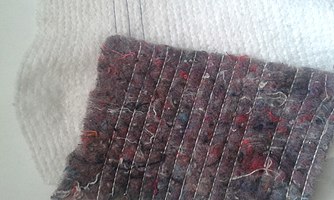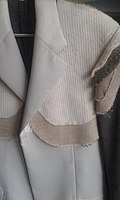Maliwatt
Maliwatt is a brand name for a non-woven sewing material , but also for the system and the process on which or according to which this textile fabric is manufactured.
In the Maliwatt stitchbonding process, the base material used is preferably a transverse fleece (for example made of wool fibers , polymer fibers , torn fibers from old textiles) or spunbonded fleece, but also a glass mat or a pre-consolidated web. The mechanical consolidation of the base material to form the Malwatt product takes place through the formation of a multitude of parallel knitted threads. As knitting threads, yarns, twines. Smooth and textured filament and foil threads are processed. Basic ties are fringe and tricot .
The maximum working widths of the stitchbonding system and thus of the Maliwat products are 2900 mm, 4150 mm and 6150 mm, whereby a stepless reduction is possible. The basis weight of the Maliwatt products 30 may - 3000 g / m² and thickness 0.5 - mm 20th The degree of consolidation of the nonwoven sewing materials depends on the number of thread loops per unit area. It is the product of the number of wales per unit of length and row density per unit of length. The wales run in the machine working direction, the courses at right angles to it. The wale density is determined by the machine fineness, i.e. the number of knitting elements per 25 mm working width. It is between 0.5 and 22. The course density depends on the stitch length, which is between 0.5 and 5 mm. Both the machine fineness and the stitch length are product-dependent process variables.
Main applications of Mali watt products are blankets, cleaning cloths, upholstery fabrics, tape coating carrier and Dekoware., But are also suitable for interlining and functional textiles, such as household towels, washable diapers, tufting -Grundware, medical, technical and geotextiles .
See also
Individual evidence
- ↑ Hilmar Fuchs, Wilhelm Albrecht (Ed.): Nonwovens - Raw materials, production, application, properties, testing. 2nd edition, Wiley-VCH Verlag, Weinheim 2012, ISBN 978-3-527-31519-2 , p. 320
- ↑ DIN 61211: 2005-05: Textile fabrics produced on stitchbonding machines - Technological classification, terms.
- ↑ Hilmar Fuchs, Wilhelm Albrecht (Ed.): Nonwovens - Raw materials, production, application, properties, testing. 2nd edition, Wiley-VCH Verlag, Weinheim 2012, ISBN 978-3-527-31519-2 , p. 321/322
- ^ Siegfried Ploch, Peter Böttcher, Dieter Scharch: Malimo sewing technology. Fachbuchverlag, Leipzig 1978, pp. 107-109.
- ↑ Alfons Hofer: Textile and Model Lexicon . 7th edition, Volume 2, Deutscher Fachverlag, Frankfurt am Main 1997, keyword “Maliwatt”. ISBN 3-87150-518-8 .
- ↑ a b c d "Torsten Großer: Technical development of stitchbonding machines in the nonwovens sector. 21st Hofer Vliesstofftage, 8./9. November 2006. “Contains the cross-section of a workstation of the Maliwatt stitchbonding machine . Website of the Hofer Vliesstofftage. Retrieved November 14, 2019.
- ↑ Marcus Oliver Weber, Klaus-Peter Weber: Knitting and knitting - technologies - bindings - production examples. 6th, completely revised and updated edition, Deutscher Fachverlag, Frankfurt am Main 2014, ISBN 978-3-86641-299-6 , p. 224.
- ↑ Hilmar Fuchs, Wilhelm Albrecht (Ed.): Nonwovens - Raw materials, production, application, properties, testing. 2nd edition, Wiley-VCH Verlag, Weinheim 2012, ISBN 978-3-527-31519-2 , p. 323/324.
- ↑ Alfons Hofer: Textile and Model Lexicon . 7th edition, Volume 2, Deutscher Fachverlag, Frankfurt am Main 1997, keyword “Maliwatt”. ISBN 3-87150-518-8 .

